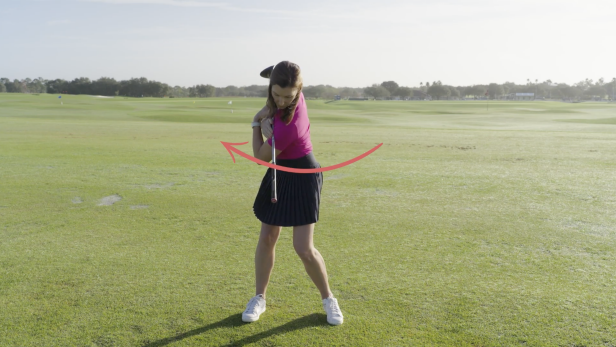Golf
3 tips for lengthening your backswing (the good way!)

When done properly, a longer backswing can increase your swing speeds, power and distance—all good things for your golf game.
But, many golfers misinterpret this and over do it. Taking the club back too far can cause inconsistent strikes and even a loss in power. So, how exactly do you find the happy medium and create a swing that’s long enough to maximize power, but short enough to stay in control and not compromise consistency?
This two-step guide can help. Follow these simple steps to crank up your backswing and give your game a boost — Erika Larkin, The Club at Creighton Farms, Aldie, V.A., Golf Digest 50 Best Teacher, Golf Digest Best in State Teacher.
HOW TO LENGTHEN YOUR BACKSWING
- Lead shoulder behind the ball
- Load into your trail hip
- Find a two-beat tempo
Powerful Backswing Tip #1: Lead Shoulder Behind Ball
When your upper body rotates properly, Larkin says it gives your arms the ability to have more width and height at the top. Many golfers struggle to do this properly because they don’t maintain their mobility or flexibility.
“If you don’t, or can’t, turn your chest, your arms will fold back behind you. You’ll start to lose that width and a lot of times you’ll end up with breakdowns through your elbow,” Larkin says.
To create a wider, longer swing, Larkin says to think about getting your lead shoulder behind your standard ball position. Turning your torso to face away from the target naturally sets a radius that’s a little wider and creates more leverage.
One thing Larkin says to watch out for here is your arm position. To maintain that leverage, you have to keep your arms out in front of you. A tendency for some players is to get too far inside when making the extended shoulder rotation.
Powerful Backswing Tip #2: Load Trail Hip
To load your trail hip properly, Larkin says to remember a few keys. First, that you’re rotating around a fixed point. Because you’re rotating on an axis, your trail hip might be slightly higher than the lead hip. Larkin says that’s okay and to be expected if you’re rotating your lower body properly. But there can be too much of a good thing. To maintain a proper hip tilt, try to keep a slight bend in your knees during the backswing.
“Think about keeping your knees soft as you turn your pelvis, this will help you feel like you’re loading into your trail hip,” Larkin says.
The next thing Larkin mentions is to limit your turn to 45 degrees to maintain stability in your foot. In the backswing, your foot, ankle and knee all work together to create the fixed point that your hips and pelvis turn around. If you turn too much, it can cause you to spin out and lose stability in those key areas.
Larkin says a good rule of thumb to follow is to make 90 degrees of rotation with your chest and 45 degrees of rotation with your hips and pelvis. If you struggle with hip mobility, Larkin says to try lifting the lead heel.
“This will allow you to gain a bit more range of motion,” Larkin says, “Letting that left heel lift gives you a bit more pelvis rotation which also allows you to increase your chest rotation.”
Powerful Backswing Tip #3: Two-Beat Tempo
One last key that Larkin mentions for lengthening your backswing is to have a good tempo.
“Don’t be quick to rush into your downswing,” Larkin says, “That will cut off the size of your backswing.”
Larkin suggests taking two beats at the top of the swing. And a good way to do that is to pick a word with three or four syllables.
And according to Larkin, it could be as simple as saying the name of your favorite tour pro. Arnold Palmer, Tiger Woods, Scottie Scheffler and Rory McIlroy are all good examples.
Give yourself the two beats to get to the top of your backswing and you say their first name, Ar-nold, then, start the downswing as you say their last name Pal-mer. This is a great tool for players that tend to get too quick.
There you have it, two simple steps to a longer backswing and an added key that will keep your swing in sync.










